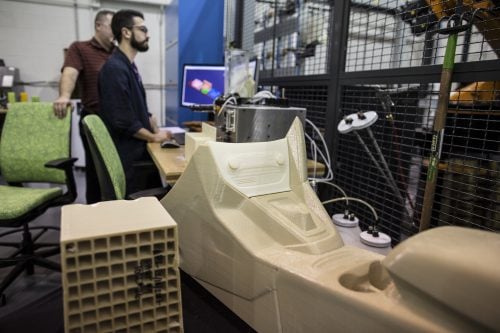In order to explore the technology’s potential for producing future vehicles, Ford Motor Company have started 3D-printing car parts in a trial.
The US-headquartered multinational car-maker is teaming up with Stratasys, a large US-based manufacturer of 3D printers and 3D production systems.
 Ford say 3D-printing car parts in plastic means they can make them much lighter in weight than their cast metal counterparts. Image: Ford
Ford say 3D-printing car parts in plastic means they can make them much lighter in weight than their cast metal counterparts. Image: Ford
The trial is taking place at Ford Research and Innovation Center in Dearborn, MI, where the Stratasys Infinite Build system will be 3D-printing car parts such as spoilers and other large-scale items.
The 3D printer – which fills a room – can fabricate large plastic parts of practically any shape or length.
Ford say that one advantage they can see from using 3D printing in this way is that the parts are considerably lighter in weight than cast metal parts, a feature that can improve fuel efficiency.
Faster prototyping
Another advantage of 3D printing is the much reduced time to produce the object, be it a tool or a part. In just a few hours, the car maker can be 3D-printing car parts from computer-aided designs.
This is a particular benefit to prototyping – when there may be several cycles of design and test, as Ellen Lee, Ford technical leader, additive manufacturing research, explains:
“With Infinite Build technology, we can print large tools, fixtures and components, making us more nimble in design iterations.”
How it works
The computer that controls the 3D printer takes the part specifications from the computer-aided design, analyzes it, and translates it into instructions for the printer, which ‘prints’ out the component one layer of material at a time.
The system detects when canisters of raw material are empty and alerts a robotic arm that automatically replaces it with a full one.
The printer can run like this for hours and even days by itself, say Ford.
Ford give the example of a new intake manifold. With traditional methods, it can take months to make the part from the designer’s computer model. With 3D printing, it can be available in two days, and at much lower cost.
Ideal for low-volume, personalized car parts
While the cost-effectiveness of 3D printing does not yet lend itself to volume production, Ford can envisage it being used to make personalized car parts, and also to make tools, prototype parts, and components for their low-volume vehicles – such as Ford Performance products.
3D printing is entering mainstream manufacturing in many areas of application, ranging from aerospace to medicine to education.
Analysts suggest that advances in technology, backed by government support, plus widening areas of application and falling costs is expected to push the 3D printing market to US$9.6 billion by 2020.
Video of Ford-Stratasys trial of 3D-printing car parts
The following short video shows the 3D printer that Ford is testing and some examples of the car parts it can produce.
